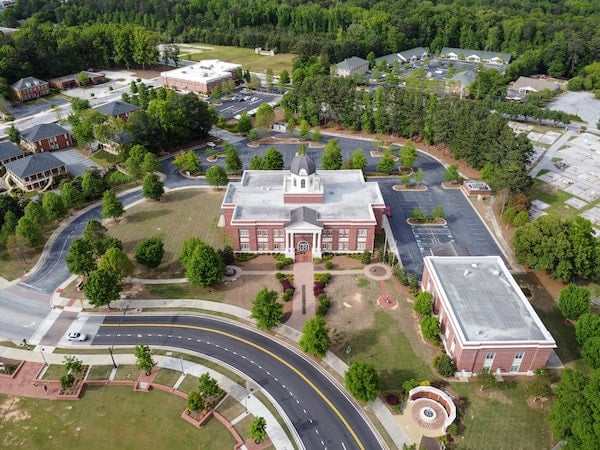Published on
How HBCUs Are Using Auxiliary Services in the New Working World

Auxiliary services are a critical source of revenue, especially for HBCUs. With the pandemic causing much uncertainty around higher education’s return to campus, these institutions are faced with financial threats and a lack of resources to keep their schools functioning. Fortunately, with state funding and the CARES Act, some can stay afloat, but they still need to think creatively about allocating funding and providing support services in a remote environment. In this interview, Peggy Valentine discusses auxiliary services, the important role they play for HBCUs, and how the virtual environment will inevitably reshape higher education’s future.
The EvoLLLution (Evo): Why are auxiliary services, and the revenue that they generate in particular, so important for HBCUs?
Peggy Valentine (PV): HBCUs receive a very limited amount of funding from their endowment account, so we rely very heavily on auxiliary services–the fees that students pay for athletics, dining, housing, healthcare, security, and so forth. These fees help us stretch our budget while allowing students to have an HBCU experience. Students choose to come to an HBCU because these institutions are unique places. The experience that you would get on an HBCU campus, one would unlikely find on another campus.
Evo: How would you define auxiliary services?
PV: Auxiliary services receive the fees that students pay beyond their tuition. For example, if one thousand students pay one thousand dollars in auxiliary fees, the university can use some of those funds for cafeteria food, and possibly leverage those fees for other supplemental activities. Thus, some of the money comes back to the university and we can use that leftover portion for scholarship money or to improve our student’s HBCU experience. In addition, some of that money could even be used to cover student travel costs to universities and for internships. This revenue all comes back to the university in ways that help offset costs– even if we don’t have an endowment.
Evo: When we talk about the auxiliary service in terms of the makeup of the budget, what percentages are we talking about?
PV: For Fayetteville State University, it’s 17%–a significant amount of money. Students pay tuition, and then, being part of a state institution, we receive resources from the state to supplement that allocation. We combine tax dollars with auxiliary service fees to cover things that we otherwise don’t have the resources to cover.
Evo: When it comes to serving the community, what fits into auxiliary services?
PV: Some services could include gym access or parking space. The collective money then can be used to maintain the gym’s facilities, repave the parking lot, upkeep buildings, and other costs for which you cannot use state funds. So, these funds must be viewed as ‘important.’ These are urgent resources and the campus depends on them.
Evo: How has the pandemic affected Fayetteville State’s capacity to deliver those auxiliary services?
PV: When the pandemic really took hold, especially in North Carolina, we had to move the students off campus. As a result, dining and housing services ceased, except for students who didn’t have anywhere else to go. If we had to reimburse those costs without the CARES Act funding, we would have been in deep trouble.
The CARES Act funding came in at about five million dollars. On top of that, there was also some money set aside specifically for HBCUs, which gave us another six million dollars; the state contributed around one million dollars as well. That really helped us reimburse costs and purchase supplies for the upcoming academic year, and to make sure that the campus remains safe from COVID-19.
With the disruption of the campus life due to COVID-19, we had to find a way to support our students. Once you go home, the typical student services accessed through auxiliary services stop. However, the employees who work for these auxiliary services, and who are supported by auxiliary dollars, were able to remain employed. We were able to provide online counseling and support for students who were graduating and were seeking employment. They could go to our website and could video chat with each other and get the support to help them with resumes and other services that auxiliary fees would typically support.
One thing that did end was athletic services. We weren’t able to continue offering sports etc., but we were still able to provide counseling, career and healthcare services.
Evo: The CARES Act funding tends to have some unclear restrictions and guidelines around how the funding should be used. How did Fayetteville State navigate that confusing period between when funding was distributed and now?
PV: Our enrollment management office created an application form, and students who were eligible applied for assistance — each had to submit –this application to the enrollment management services. The office screened the applications and selected worthy students to be awarded up to $1,000 each. We also have an amazing business-finance administrative office, and its staff makes sure that we adhered to the letter of the law in distributing those funds, because nobody wanted this to be grounds for auditing. They made sure that we used the funds as they were intended.
For example, there were a lot of students who went home who didn’t have computers, so we purchased some computers and made them available to those in need.
The other issue that we faced when surviving remotely was the lack of accessible wifi. We had to look into ways in which we could help the students access the Internet. For many of our faculty, it was their first time teaching online, so we provided workshops and training sessions for them to reconfigure their courses and teach online. Even the physical classrooms have been adjusted in accordance with social distancing: barriers, masks, and hand sanitizing stations are placed everywhere on campus. A lot has taken place to make sure that the campus is COVID-19- ready.
Evo: How can colleges and universities continue to leverage auxiliary resources to continue supporting the community and its students, even in this very differently structured environment?
PV: We first have to realize that the world is changing. Higher education will not be the same as it was when I was a student, so we have to be prepared for this new world. Right now, all of these K-12 students who have been taking courses online at home are having experiences that will transfer into their college experiences in a few years. Of those who are in college and who were reluctant to learn online, we found that 80% of learners found it wasn’t as bad as they thought. They have adjusted.
Virtual learning is becoming more and more commonplace. There are now virtual classrooms that can be entered by using your computer, create your own avatar, enter a specific classroom setting, collaborate with other students, and raise your hand for the instructor’s attention. Everyone is on the computer at the same time. The challenge for higher education is making virtual learning exciting for students so they will want to join the world of virtual learning environment. But it’s here, and it’s an opportunity for entrepreneurs to create platforms to engage students in a greater way than they have done in the past.
Telehealth is a huge electronic service. You don’t even have to touch a patient. You can communicate with them virtually and on a regular basis to monitor their symptoms and to ensure that they’re okay. They can in turn show you their ailments. Higher education is usually slow to change, but virtual learning is pushing it forward speedily.
E-sports is another great example of virtual connections. I’d never heard of it until a couple of years ago, and it has become over a multi-billion-dollar industry now. There are educational programs in which students learn the business of e-sports virtually–how to become an announcer, recruiter, manager. All of these are skills that students can learn from e-sports and will eventually help them when they graduate from college and land a job, whether it’s in the e-sports industry or not.
After the 1918 influenza pandemic, the world changed. With this new pandemic, the world will unquestionably become more technological.
Evo: As we shift to online learning and focus more on serving adults, what are you envisioning for the future of auxiliary services and auxiliary revenue?
PV: Higher education needs to look at that future that we’re entering and very rapidly reconfigure the use of auxiliary funds. There may be more funds directed toward technology. Alternatively, there may be less for dining and living accommodations on campus, because it’s possible that students may commute more than before. People will be more careful when they go out in large crowds. People will want to experience things more virtually—like basketball games or football games–so there will need to be a reconfiguration of how auxiliary funds are designated and how they are used.
Evo: Is there anything you’d like to add about how you see the reliance on and the use of auxiliary services changing, and then how you see the nature of auxiliary services modernizing?
PV: When it comes to sports and the virtual environment, there will be more virtual celebrations. HBCUs have their own unique culture, in which homecoming and parties play a big part. There’s a group called the Central Intercollegiate Athletic Association (CIAA). Within that organization there are 12 HBCUs. When the pandemic hit, they were thinking of how they could keep students, members and alumni engaged, so they came up with virtual parties. You could tune in on your computer at a certain time of the day, and a DJ would play music. This went on for hours, with different time slots were scheduled for different schools, and people had a great time in the comfort of their home.
So that’s just one example of how upward we’re advancing. People want to have fun experiences, but they don’t want to expose themselves to getting sick. As our social environment changes, people want to find ways to entertain themselves and connect with others so that they don’t feel so stuck at home. This virtual world is coming upon us very quickly.
This interview was edited for length and clarity.
Disclaimer: Embedded links in articles don’t represent author endorsement, but aim to provide readers with additional context and service.
Author Perspective: Administrator


